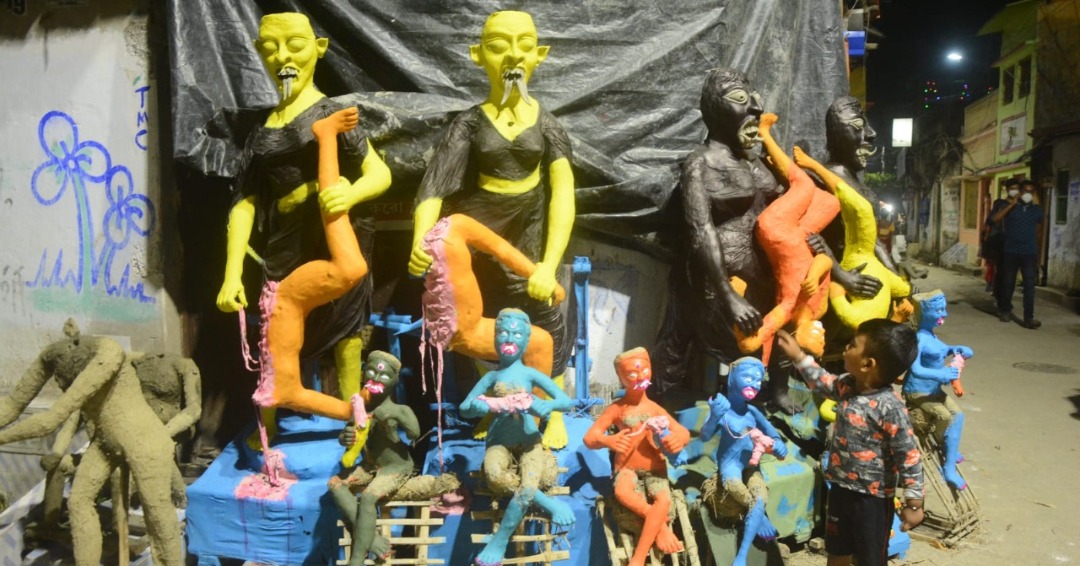If you walk through the winding lanes of Kolkata’s potter’s colony Kumartuli ahead of Kali Puja, you will find scary idols of demons and ghosts put on display! Demons are standing in rows. Some have their eyes bulging out, some have blood oozing from their teeth. Some have only one torso and two heads. Forget children, even adults will be scared to see these idols.
The more terrifying the idol looks, the higher is it price! But what are these idols? Why are they sold before Kali Puja? Are these idols worshipped? Who worships them and why?
Do not mistake these for Halloween props! These are the idols of Dakinis and Yoginis—spiritual companions of Goddess Kali. Even though they look scary, Dakinis and Yoginis are worshipped along with the Goddess on the occasion of Kali Puja in West Bengal.
View this post on Instagram
Who are Dakinis and Yoginis?
Despite their fearsome appearance, Dakinis and Yoginis hold deep religious significance.
According to religious and mythological interpretations, dakinis and yoginis are female beings with special spiritual powers, who are described in various forms. Conceptions of them may vary in different traditions, such as the Tantras of Hinduism and Buddhism.

Dakini is a type of female being, goddess or spirit. In some accounts, they are also referred to as demons or demons.
In Hindu Tantra, Dakinis are attendants or companions of goddesses Kali or Durga. They can have various forms, and can protect or obstruct seekers.
In Tibetan Buddhism, Dakinis are described as ‘sky dancers’ or ‘sky dwellers’. Here they are the sacred form of femininity and symbols of deep wisdom and emptiness.
The word Dakini is the feminine of the word ‘dak’, which means wise. In the past, a wise woman was given the title ‘Dakini’. Many of them were Tantric sages and professors at educational institutions like Vikramshila University. This term is also used in Vajrayana Buddhism.
Yoginis are female beings who have attained spiritual power. Some of them act as companions of the goddess and manifest various powers of the goddess.
Why are Dakinis and Yoginis kept next to Goddess Kali and worshipped?
Dakinis and Yoginis are companions of the fearsome form of Kali, representing both the destructive and creative aspects of the goddess.
Dakinis-yoginis are associated with the Tantric movement of the Pala period, which is an important part of the worship of Kali. According to some interpretations, Dakinis-Yoginis are symbols of the three gunas—sattva, raja, and tama—which influence human actions and nature.

In the traditional worship of Dakshinakali, after worshipping the main goddess, her attendant Dakinis-Yoginis are worshipped.
The main reason for placing Dakini Yoginis next to Kali statues is that they are companions of the goddess and are associated with the Tantric tradition. Dakinis were wise women who were skilled in tantric practices, and yoginis were symbols of the power and transformation of the goddess. Dakini-Yogini symbolise the fierce form of Kali and the spiritual and tantric power behind it.
Demand for Dakini-Yogini idols in Kolkata’s Kumartuli
Just as the idols of Goddess Kali are sold before Kali Puja in Kolkata’s Kumartuli, people are seen carrying idols of Dakinis and yoginis at the Kumartuli temple on the eve of Kali Puja which are transported in vehicles like bicycle van, truck or mini-truck.

Two idols of Dakinis and Yoginis are placed on either side of Goddess Kali’s idol. The more terrifying they look, the higher is the price. The attire of the Dakini-Yogini of Kumartuli village is also surprising. Some of them wear jerseys of the Brazilian and Argentine football teams, some of them wear nighties, and some are modern in jeans-tops. Along with the idols of Maa Kali, Dakini-Yogini also provide good business to the potters during Kali Puja.
The price of a slightly larger Dakini-Yogini idol varies from Rs 3,000 to Rs 4,000 in Kolkata, while the medium ones cost between Rs 1,600 and 2,000. The ones that are very small in size are being sold for only Rs 600 to 700. However, most Kali Puja organisers prefer Dakini-Yogini idols which are massive and terrifying.
Bhoot Chaturdashi: Connection between Goddess Kali and ghosts
There is a connection between ghosts and Kali Puja. The day before Kali puja is Naraka Chaturdashi, which is observed as Bhoot Chaturdashi in Bengal. It is said that on Bhoot Chaturdashi, deceased ancestors descend to earth. People pray for their souls through various rituals. In the evening of Bhoot Chaturdashi, 14 lamps are lit to drive away evil spirits. On the same day, Dakini-Yogini come to earth as the followers of Kali.
Actually, Dakini or Yogini, neither demon nor evil. Dakini is a wise woman, and Yogini is a worshiper of power. According to mythology, they are not only followers of Maa Kali, but also her incarnation deity. Therefore, after the puja of Maa Kali, the priest worships Dakini-Yogini with devotion.
So next time you see those fierce faces beside Goddess Kali, remember—they’re not here to scare, but to protect and empower!



